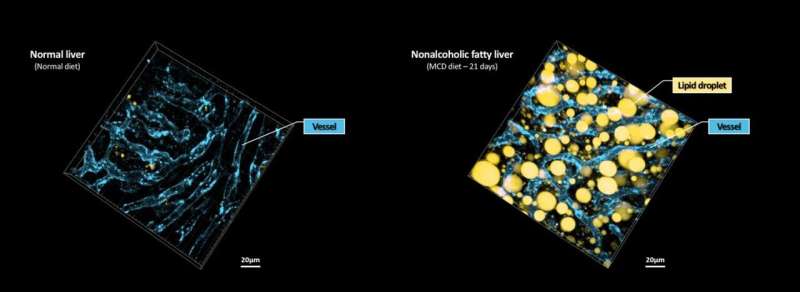Microscopy approach poised to offer new insights into liver disease

Researchers have developed a new way to visualize the progression of nonalcoholic fatty liver disease (NAFLD) in mouse models of the disease. The new microscopy method provides a high-resolution 3-D view that could lead to important new insights into NAFLD, a condition in which too much fat is stored in the liver.
"It is estimated that a quarter of the adult global population has NAFLD, yet an effective treatment strategy has not been found," said professor Pilhan Kim from the Graduate School of Medical Science and Engineering in the Korea Advanced Institute of Science and Technology. "NAFLD is associated with obesity and type 2 diabetes and can sometimes progress to liver failure in serious case."
In The Optical Society (OSA) journal Biomedical Optics Express, Kim and colleagues report their new imaging technique and show that it can be used to observe how tiny droplets of fat, or lipids, accumulate in the liver cells of living mice over time.
"It has been challenging to find a treatment strategy for NAFLD because most studies examine excised liver tissue that represents just one timepoint in disease progression," said Kim. "Our technique can capture details of lipid accumulation over time, providing a highly useful research tool for identifying the multiple parameters that likely contribute to the disease and could be targeted with treatment."
Watching disease progression in real-time
Capturing the dynamics of NAFLD in living mouse models of the disease requires the ability to observe quickly changing interactions of biological components in intact tissue in real-time. To accomplish this, the researchers developed a custom intravital confocal and two-photon microscopy system that acquires images of multiple fluorescent labels at video-rate with cellular resolution.
"With video-rate imaging capability, the continuous movement of liver tissue in live mice due to breathing and heart beating could be tracked in real time and precisely compensated," said Kim. "This provided motion-artifact free high-resolution images of cellular and sub-cellular sized individual lipid droplets."
The key to fast imaging was a polygonal mirror that rotated at more than 240 miles per hour to provide extremely fast laser scanning. The researchers also incorporated four different lasers and four high-sensitivity optical detectors into the setup so that they could acquire multi-color images to capture different color fluorescent probes used to label the lipid droplets and microvasculature in the livers of live mice.
"Our approach can capture real-time changes in cell behavior and morphology, vascular structure and function, and the spatiotemporal localization of biological components while directly visualizing of lipid droplet development in NAFLD progression," said Kim. "It also allows the analysis of the highly complex behaviors of various immune cells as NAFLD progresses."
The researchers demonstrated their approach by using it to observe the development and spatial distribution of lipid droplets in individual mice with NAFLD induced by a methionine and choline-deficient diet. Next, they plan to use it to study how the liver microenvironment changes during NAFLD progression by imaging the same mouse over time. They also want to use their microscope technique to visualize various immune cells and lipid droplets to better understand the complex liver microenvironment in NAFLD progression.
More information: Jieun Moon et al, Intravital longitudinal imaging of hepatic lipid droplet accumulation in a murine model for nonalcoholic fatty liver disease, Biomedical Optics Express (2020). DOI: 10.1364/BOE.395890




















